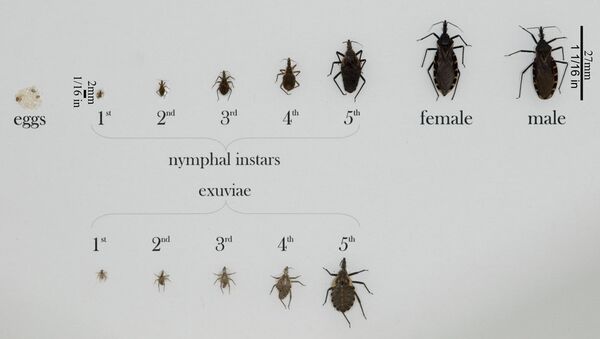Chagas disease is caused by a parasite, trypansosoma cruzi, and there is no vaccine for it. The parasite lives inside tiny insects, known as "kissing bugs" or "assassin bugs," which dwell in the roof spaces of impoverished communities.
According to the World Health Organization, more than 10,000 people die every year from Chagas disease, which is named after Carlos Chagas, the Brazilian scientist who discovered it, and is endemic in 21 countries in Latin America.
But Dr. Peter Hotez, the Dean of the National School of Tropical Medicine at Baylor College of Medicine in Houston, Texas, said he believed the annual death toll may be much higher.
"The 10,000 a year figure is probably an under-estimate. It is probably more like 40,000 a year," Dr. Hotez told Sputnik.
Chagas has been ignored, says Dr. Hotez, while many countries in Latin America have been obsessed with the fight against the Zika virus. Earlier this month a report exposed the scale of bribery and corruption in the pharmaceutical and health care sector in Latin America.
Assassin bugs, specifically "kissing bugs" feed on the blood of vertebrate and spread Chagas' disease, endemic in South and Centeral America pic.twitter.com/OSCmSOdaST
— jewlz Ⓥ (@jewiwee) May 7, 2017
Dr. Hotez claimed many governments have ignored Chagas disease, because it predominantly affects impoverished communities with little political clout.
"The US government and all the Latin American governments have turned their back on people with Chagas. There has been no effort to do surveillance or screening, let alone fund research into treatment," he told Sputnik.
Dr. Hotez said a Chagas coalition had been formed by seven medical and scientific institutes in North and Latin America but he said they were finding it difficult to get the funding to research clinical trials.
Originally only wild animals were infected with the parasite, but in the last few centuries it spread to domestic animals and then inevitably to humans.
Dr. Hotez explained how humans become infected: "The kissing bugs nest in the thatched roofs of loq quality housing. They are similar to cockroaches. They usually come out at night. They feed on blood so when they bite people they also defecate bloodmeal, which contains the parasite."
He said the parasite, which is microscopic, then lies dormant in the body for a decade or more.
"People get infected, but although there may be a swelling in the face, usually there is nothing, so it will go undiagnosed. This silent period is crucial. A third of Chagas patients will eventually develop heart disease, cardiac myopathy. Some also develop gastro-intestinal problems," said Dr. Hotez.
He said the parasites could be transmitted from mother to baby and also through blood or organ transplants, which meant screening was vitally important.
Because of the huge reservoir of the bugs in Latin American, there is no hope of eradicating it, but only controlling it.
It is vital that infected patients are diagnosed as soon as possible and blood and organ transplants are properly screened.
The parasite which spreads Chagas disease shares many similarities with the bugs which have been spreading leishmaniasis, a deadly flesh-eating disease which is spreading across the US.
The disease has spread to Spain and Italy, mainly brought by Latin American immigrants and it is increasingly cropping up in the US and Canada.
"There are an estimated 10,000 people infected with Chagas in Italy and around 40,000 in Spain. In the US it has been mainly brought in by immigrants but in addition there is also transmission in Texas, probably caused by wild animals. There are people who have got it who have never left Texas," Dr. Hotez told Sputnik.
Dr. Hotez said money could be saved in the long-term by carrying out active screening now.
He also said that early diagnosis of infection improved the chances of treating the disease.
"We should be screening the whole of Texas, but we don't do that," Dr. Hotez concluded.

